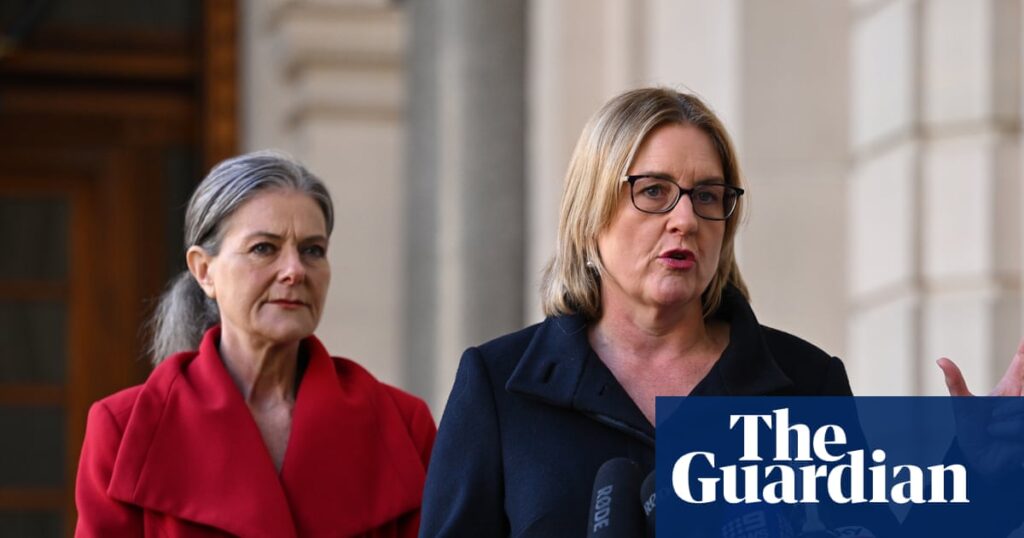Apartment towers of up to 16 storeys will be built across Melbourne’s inner suburbs – including in well-heeled bayside where residents rallied against the plan – according to new draft maps released by the Victorian government.
The premier, Jacinta Allan, and the planning minister, Sonya Kilkenny, on Wednesday released the maps showing proposed heights and boundaries for 25 of the government’s 50 activity centres across Melbourne, which were first announced in October 2024.
Under the plan, the state government will seize planning controls for the designated areas – located near train and tram stops – from local councils to allow greater density, increased building heights, faster approval processes and fewer avenues for appeal, in an effort to significantly increase housing supply.
Sign up: AU Breaking News email
While the initial plan considered towers of up to 20 storeys, the draft maps show that none of the 25 centres will reach that height – with 16 storeys being the tallest proposed for the bayside suburb of Hampton, Oakleigh in the south-east and along the tram line in Kew and at Auburn and Hawthorn train stations in the inner-east.
A large stretch of Sydney Road from Coburg through to Brunswick, in the inner north, is also proposed to reach up to 16 storeys. Nearby tram routes along High Street and St George’s Road have proposed limits of 12 and six storeys, respectively.
At Middle Brighton, where residents and the local MP, James Newbury, gathered to oppose the proposal in a much-publicised protest, the proposed maximum height will be 12 storeys. A similar proposed height limit applies to North Brighton and Sandringham, all located along the Sandringham train line.
Newbury, the Coalition opposition’s treasury spokesperson, on Wednesday accused the government of “trying to turn bayside into the Gold Coast”.
Glenferrie station in Hawthorn, which is connected to the Alamein, Belgrave and Lilydale train lines, and Carnegie and Hughesdale on the Cranbourne and Pakenham lines, are proposed to have building heights up to 12 storeys. Murrumbeena, located between Carnegie and Hughesdale, has a proposed cap of 10 storeys.
Nearby, along the Glen Waverley line, Holmesglen and East Malvern are slated for six storeys, Darling and Glen Iris for eight, Gardiner 12 and Tooronga 10.
In the east, Heidelberg has a proposed limit of 10 storeys, while in the west, Tottenham and West Footscray have 12 and Middle Footscray six.
Each zone also has proposed inner and outer catchments.
In the inner catchments – within a five-minute walk from the station – a height limit of four storeys, or six storeys on larger blocks of more than 1,000 square metres, is proposed.
In the outer catchments – up to a 10-minute walk from the station – there is a proposed limit of three storeys, or four on larger blocks.
The government said in both catchments, the right of residents to appeal development “will not change” and “heritage and landscape overlays will stay in place”.
However, in the “core” areas around the stations, eligible buildings will be “deemed to comply” with planning rules and unable to be challenged at the Victorian civil and administrative tribunal.
Applications that exceed the specified height of the site are not eligible for the fast-tracked pathway and must go through a regular planning process.
after newsletter promotion
Allan was undeterred by criticism of the plan. She told reporters the “status quo” was not an option and she would not allow young people to be priced out of living in the areas they grew up in, close to jobs and services.
“We’ve got to keep building more homes because the alternative that the Liberal party are pushing is to lock people out of the suburbs. And that doesn’t just lock them out of their homes and their opportunities, it also makes the affordability challenge even harder,” she said.
Kilkenny said local government areas such as Bayside and Boroondara had only grown by about 30% in the last three decades compared to the outer councils such as Melton and Wyndham, where there had been growth of up to 400% over the same period.
“Our populations are going backwards in these areas, and we want to stop that,” she said.
Dr Stephen Glackin, an urban planner from Swinburne University, agreed, describing the changes as a “sensible” way to combat urban sprawl.
“This ‘not in my back yard’ mentality is, as premier Jacinta Allan says, just not fair for the city as a whole,” he said.
“Sprawl has been allowed to continue and now the government is almost sending itself broke trying to make it work with new transport infrastructure, which may have been avoided if we planned for developments around existing transport assets.
“Now is a good time to plan for this.”
The release of the maps comes after community consultation, including in-person and online meetings and more than 3,000 submissions. The government will invite further feedback on the maps including heights, setbacks and boundaries in September and October.
“We’re prepared to make changes that reflect the feedback we get,” Kilkenny said.
Consultation for all 50 activity centres is expected to be completed by early 2026. They are in addition to 10 pilot centres, where new planning rules have already come into effect.

